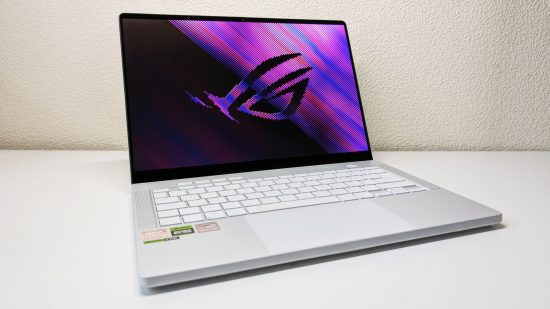Our Verdict
The sleek design of the Asus ROG Zephyrus G14 (2024) is more than just a pretty face, housing a gorgeous display and solid performance inside its premium chassis. Its flaws are relatively few, with its soldered RAM proving the most egregious one, to the point that it easily emerges as the 14-inch gaming laptop to buy if you can afford it.
- Glossy OLED display with G-Sync support
- Deliciously premium build quality
- Good gaming performance
- Soldered RAM can't be upgraded
- Minor spec upgrades from last year
- Difficult to run some games at native resolution
The promised land of minute but mighty laptops with few compromises has never felt as fully realized as it does with the Asus ROG Zephyrus G14 (2024) sitting on my desk. While falling just shy of perfection, its minor flaws do little to get in the way of what’s otherwise a superb system, inside and out. So much so, in fact, that alternatives have a hard time competing.
Serving as my daily driver, I’ve been gaming away on the Asus Zephyrus G14 for just a little under a month. In that time, it’s more than proven itself as the best gaming laptop I’ve used in this particular form factor. Its size naturally comes with some constraints, which mainly affect performance and price, but this squeeze is barely noticeable, as this laptop it never fails to keep its cool both metaphorically and under load.
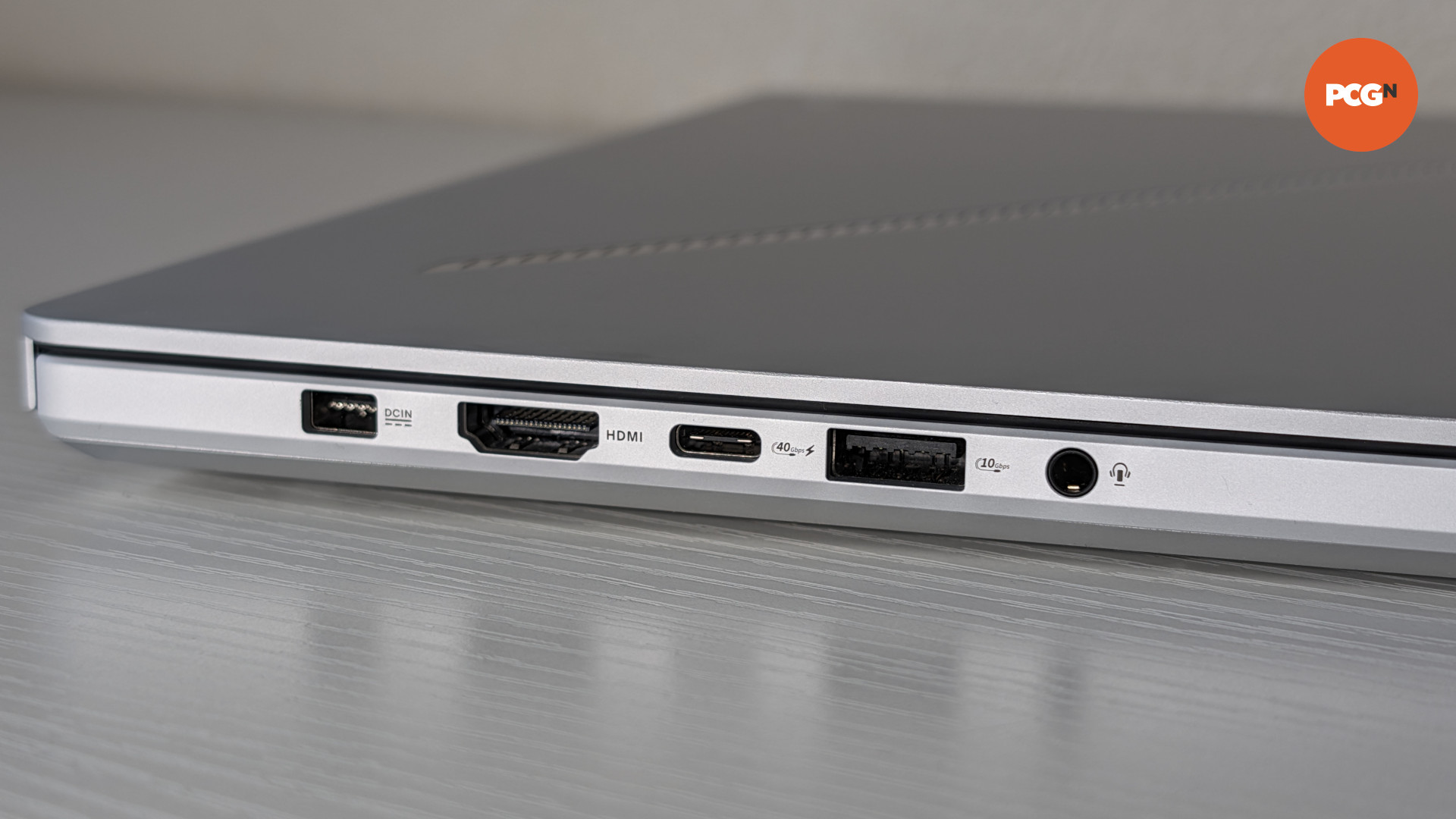
ROG Strix Zephyrus G14 (2024) design
Design changes to the ROG Strix Zephyrus G14 (2024) leave it both slimmer and smaller than last year’s model, weighing in at a relatively dainty 1.5kg and measuring just 1.6cm thick, with its length and width also receiving a trim. These measurements, combined with the Zephyrus G14’s stylish yet sturdy CNC-machined aluminum alloy chassis, make for a machine whose luxurious appearance matches its premium components.
However, Asus’ pursuit of form has consequently affected the function of the Zephyrus G14 with mixed results. One positive is that the audio system of this year’s laptop is markedly improved, with two additional speakers, making for a total of six, and a shift in the placement of grills, which now run on either side of the keyboard instead of towards the exhaust vents. Games and music sound surprisingly punchy and loud on the Zephyrus G14, despite its small stature, with the device punching above its weight and showing up bigger laptops such as the Asus ROG Strix Scar 18.
These design changes have ushered in a redesigned keyboard too, which now has keycaps that are larger than the ones on last year’s model, despite the shrunken chassis. Generational improvements aside, the Zephyrus G14’s chiclet keyboard makes for comfortable gaming and typing experiences, but a mechanical option would be welcome in future models to further push its premium qualities. Serendipitously, this keyboard design also apparently increases air intake for the internal components, according to Asus, but the company hasn’t explained how.
On the surface, then, all seems positive, but looking underneath the aluminum reveals two compromises to the internals of the Zephyrus G14, made in service of its new design. The less detrimental change is a reduction in charging capacity, down from 76WHrs to 73Whrs. In theory, this leaves the laptop slightly worse off when it comes to battery life compared to last year’s model. However, efficiencies have been made elsewhere, to the point that this has effectively become a non-issue, although capacity is still reduced regardless.
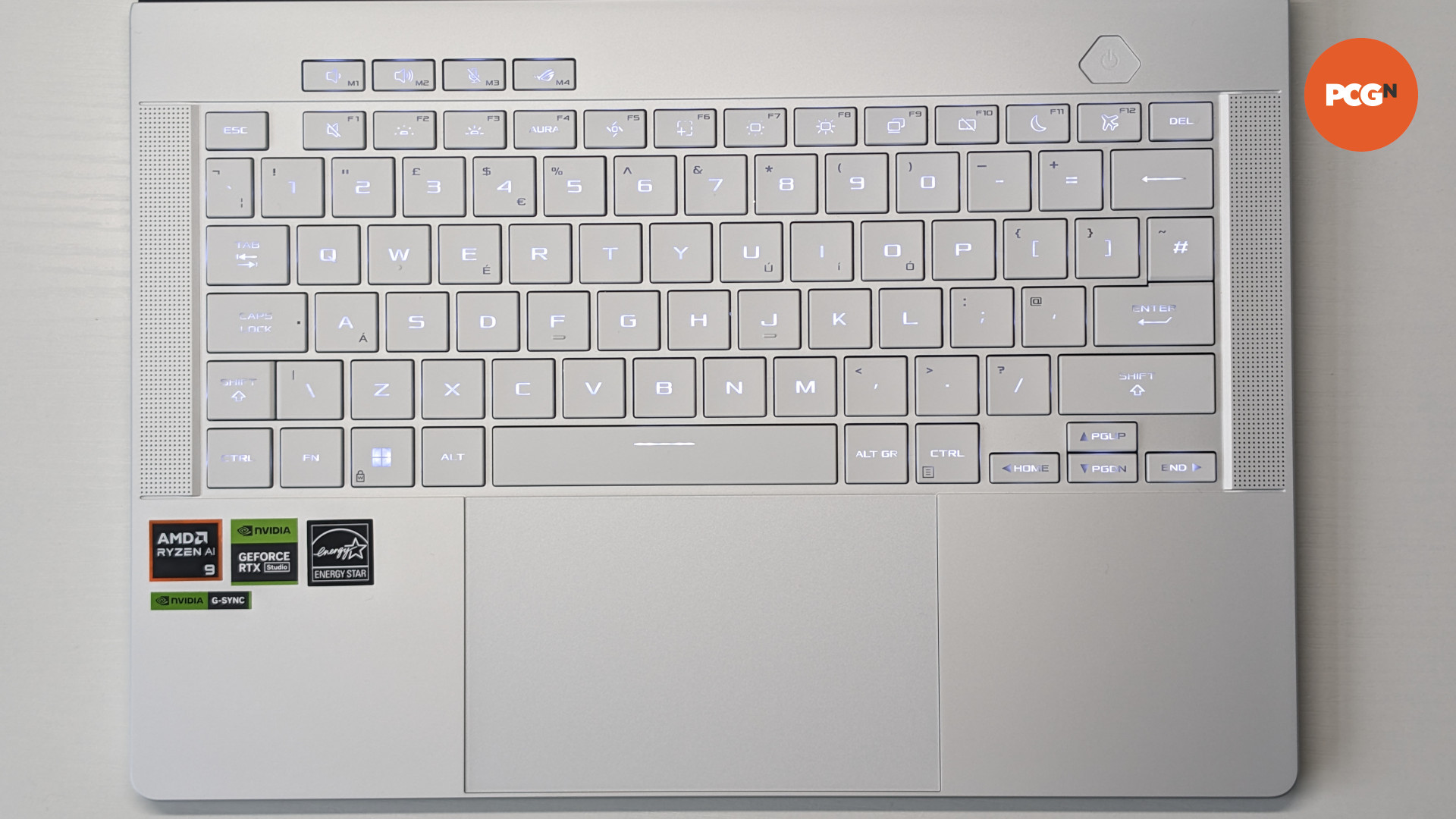
The more controversial change comes in the switch to soldered RAM, removing the ability to upgrade your memory capacity or speeds down the line, and this negatively impacts repairability too. Instead of swapping in larger or faster sticks, your only option to prolong the lifespan of the Zephyrus G14 is to buy more expensive configurations featuring 32GB of RAM right off the bat, in place of 16GB models. While an additional fan over the now soldered RAM for a tri-fan cooling system softens the blow to a degree, Asus can’t escape the heat of this design choice, especially when competitors like the Razer Blade 14 don’t make this mistake.
AniMe Matrix also makes a return on the Zephyrus G14 in a new form. Replacing the 14,969 holes found on the 2023 model, there’s now a ‘Slash Lighting’ array of LEDs. This streak of light can be customized to serve as a notification light, as well as several other functions, but it still feels like a largely superfluous addition that wouldn’t be sorely missed were it given the chop. To be clear, though, it’s a novel approach to customization that feels more appropriate to this laptop’s styling than a bar of RGB LEDs.
You’ll find the Zephyrus G14 in two colors, ‘Eclipse Gray’ and ‘Moonlight White’. Based on our experience with the latter color option, opting for the darker of the two would be the smart move, given that it provides greater contrast for the keyboard LEDs to shine. The lighter tones of our review sample can leave the keycap backlights looking a touch washed out, particularly with white selected as the color of choice.
Save for the sore spot that is its soldered RAM, the Zephyrus G14’s design is otherwise superb. It’s a pleasing sight to behold, open or closed, with a pristine, modern styling that I wish more gaming peripherals and systems would adopt, or at least emulate. It gets even more pleasing once you get hands-on with it too, making for an awesomely lavish little laptop.
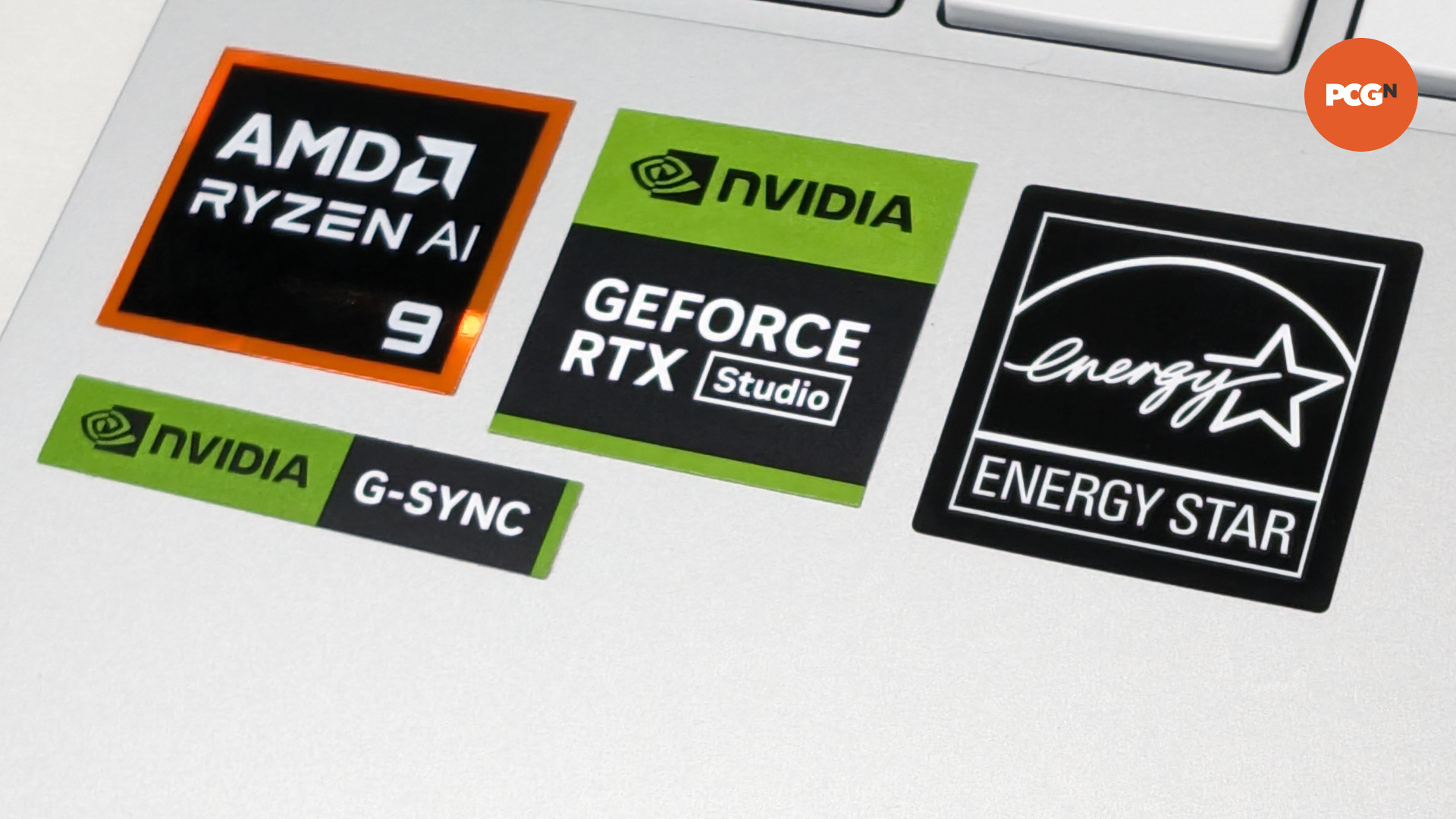
ROG Strix Zephyrus G14 (2024) specs
Internal specs for the ROG Strix Zephyrus G14 (2024) aren’t markedly different from last year, with the only notable difference being the replacement of the AMD Ryzen 9 7940HS processor with the newer AMD Ryzen 9 8945HS.
However, these two CPUs are practically identical in every way that matters, including cores, threads, and clocks, with the only difference being the inclusion of a neural processing unit (NPU) in the latter. This addition may prove useful to some creatives that use artificial intelligence in their workloads, but it does nothing for gaming at this point in time.
Our sample is the most powerful configuration you can get for the Zephyrus G14 (GA403UI-G14.R94070), featuring the aforementioned Ryzen 9 8945HS alongside an Nvidia GeForce RTX 4070, 32GB of RAM, and a 1TB PCIe 4.0 NVMe SSD. Topping out with an RTX 4070, at 95W, marks a change of pace for Asus, with the previous generation of the Zephyrus G14 rocking up to a GeForce RTX 4090 at 125W.
A choice of fewer configurations may rub some the wrong way, but RTX 4090 graphics in a chassis this small and at such a reduced wattage doesn’t make much sense in terms of value. Furthermore, while this may not be an RTX 4070 at its full 115W TDP, the additional 25W left on the table would only net you a few additional frames per second, making it a smart choice from an efficiency standpoint.
| CPU | AMD Ryzen 9 8945HS |
| GPU | Nvidia GeForce RTX 4070 (90W) |
| Display | 14-inch, 2,880 x 1,800, 120Hz, OLED |
| RAM | 32GB (2 x 16GB) LPDDR5X-6400 |
| Storage | 1TB PCIe 4.0 NVMe M.2 SSD |
| Ports | 3.5mm combo audio jack HDMI 2.1 port microSD card reader 2x USB 3.2 Gen 2 Type-A USB 3.2 Gen 2 Type-C USB 4 Type-C, w/ DP Alt and power delivery |
| Battery | 73WHrs |
| OS | Windows 11 Home |
| Dimensions (W x L x H) | 31.1 x 22.0 x 1.6cm |
| Weight | 1.5kg |
RAM in the Zephyrus G14 can’t be upgraded, as previously mentioned, but its storage is thankfully swappable should you need some additional space. Do note, though, that the laptop only has one M.2 slot, so you’ll need to clone your existing drive or go through a more involved setup process to increase your storage capacity. While I’m glad Asus has raised the floor from 512GB, a 2TB or even 4TB config would have been welcome as well.
Debuting in an Asus ROG laptop for the first time, the Zephyrus G14’s OLED display serves as the biggest shakeup in its specs. Sporting a staggeringly high resolution of 2,880 x 1800, this is a satisfyingly pin-sharp screen with excellent contrast, and its factory-calibrated color accuracy has a Delta E under one as well. What’s more, the addition of Nvidia G-Sync makes this panel a cut above the current OLED competition, eliminating tearing and stuttering artifacts in games by syncing the screen’s refresh rate with your GPU’s frame rate.
Shifting from Mini LED to OLED does have some tradeoffs, though. Aside from the obvious concern of burn-in, for which Asus provides an ‘OLED Care’ feature to mitigate, OLED simply can’t match the brightness of Mini LED, although the Zephyrus G14 puts in admirable showing here, even in sunlit outdoor scenarios. However, its self-emissive nature gives OLED the advantage when it comes to blooming, particularly in dark scenes, with vastly more dimming zones than the 504 zones found on last year’s model of this laptop.
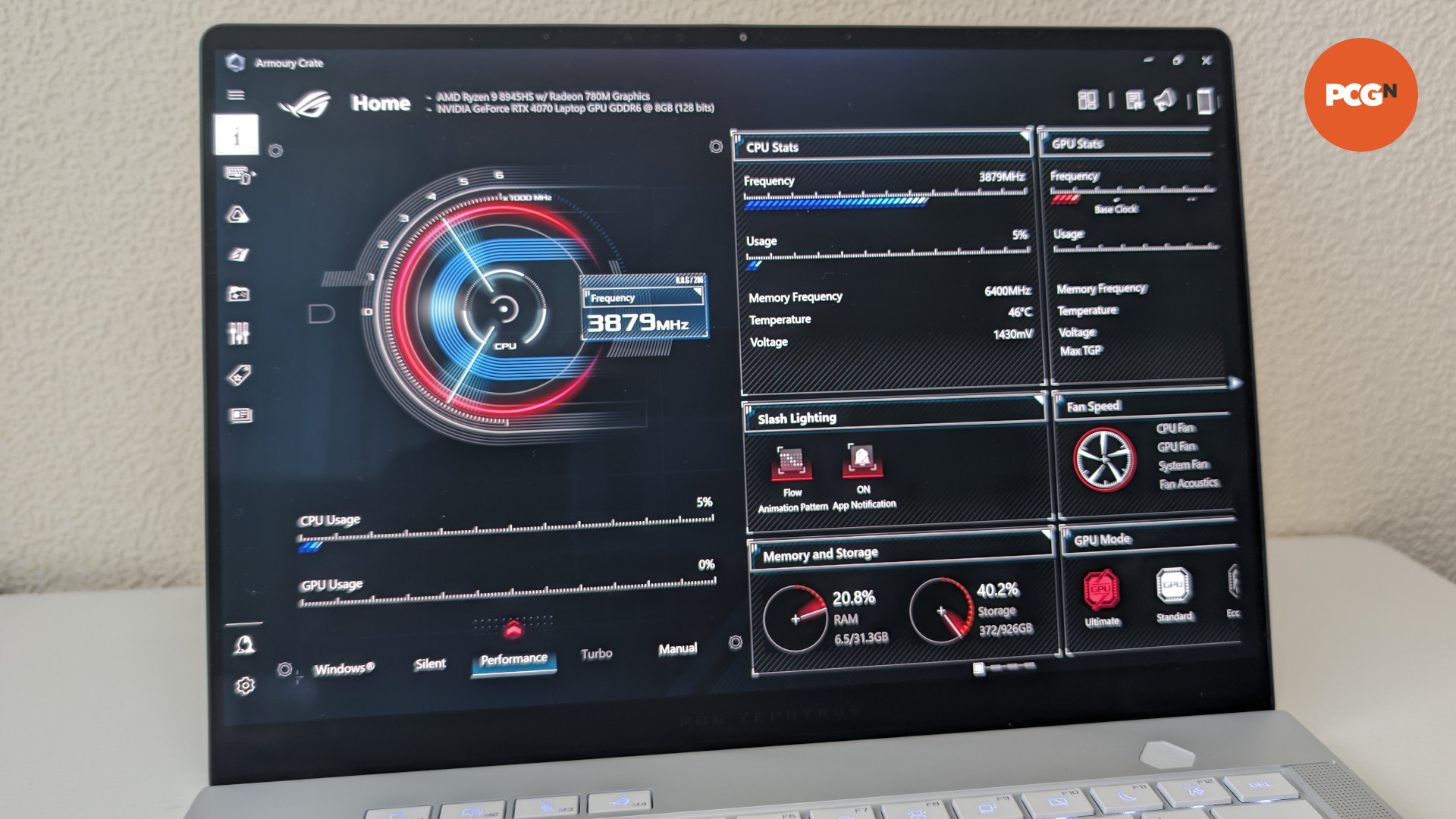
As a consequence of swapping to this particular OLED panel, though, the Zephyrus G14 finds itself more strained to run games at its native resolution, as the resolution has jumped from 1600p to 1800p.
Although this unlocks the ability to use more performance-oriented upscaling presets in DLSS, in games that support it, you’ll need to be prepared to turn the resolution down from 1800p to a more manageable 1080p or 1440p in most titles. This is a minor point of fiddliness in an otherwise pretty package that further adds to the laptop’s premium quality.
Despite the Zephyrus G14 rocking a smaller chassis in this generation, Asus hasn’t skimped out when it comes to ports either. Peripheral connections include two USB 3.2 Gen 2 Type-A ports, a single USB 3.2 Gen Type-C port, as well as a USB 4 port that supports DP-Alt mode and power delivery.
While that’s convenient, though, you’ll need to use the included power brick with Asus’ proprietary connector to get the most performance out of the laptop. In addition to DP-Alt, you also have a HDMI 2.1 port at your disposal for connecting external displays, which connects directly to the RTX 4070 rather than the iGPU, via a MUX switch for maximum performance. A 3.5mm combo audio jack and microSD card round off the selection and are welcome inclusions.
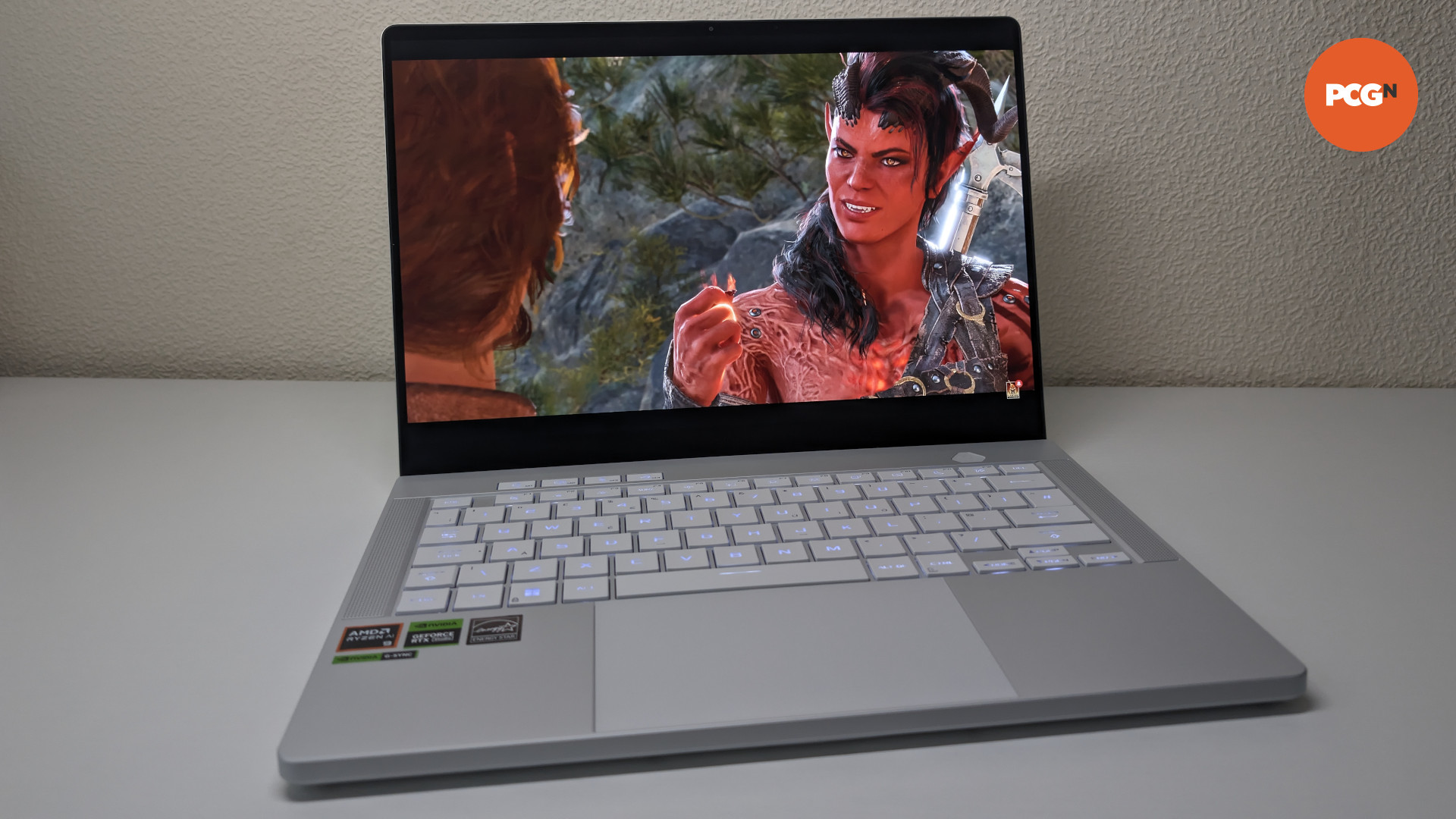
ROG Strix Zephyrus G14 (2024) benchmarks
Running the ROG Zephyrus G14 (2024) through our benchmarks suite places the laptop alongside a desktop GeForce RTX 4060 paired with an AMD Ryzen 7 7800X3D in terms of gaming performance. This isn’t too surprising given RTX 4070 mobile’s specs, but frame rates aren’t great unless you’re prepared to shift down to a lower resolution than the screen’s native 1800p.
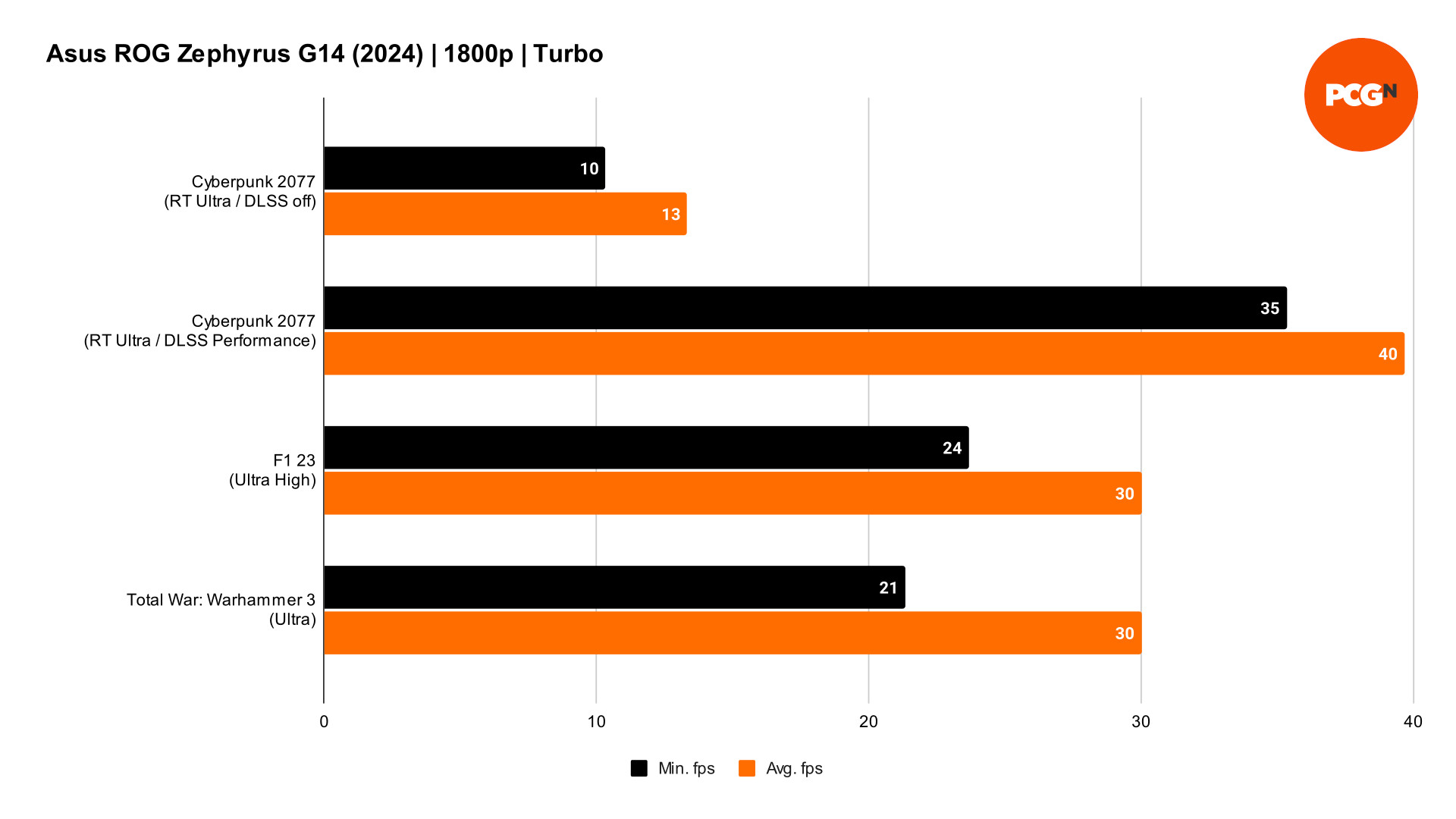
Cyberpunk 2077’s ‘RT Ultra’ preset proves too much for the Zephyrus G14 at 1800p, but this is quickly addressed once we swap to a lower resolution or, more preferably, employ DLSS Super Resolution. In DLSS ‘Performance’ mode, or 900p, the RTX 4070 inside the laptop fares much better, producing an average frame rate of 40fps, with the minimum frame rate bottoming out at 35fps. The game itself looks fantastic in this configuration too, particularly with HDR enabled, taking full advantage of the G14’s OLED display.
These frame rates are unfortunately too low for DLSS Frame Generation to be of any assistance, actually negatively impacting performance in this case, but the Zephyrus G14 does support it and makes for a great enhancement in the right circumstances.
F1 23 proves similarly troublesome for the Zephyrus G14 at its native resolution, as the game’s ray traced ‘Ultra High’ preset sees average frame rates scrape across the 30fps finish line. It does this not quite so gracefully, though, as minimum frame rates clock in at 24fps. Taking a pit stop in the settings menu, and getting your metaphorical pit crew to drop the resolution or enable DLSS Super Resolution, naturally alleviates this bottleneck, though.
While DLSS can salvage performance in many games, retaining all the essential details, titles like Total War: Warhammer 3 don’t enjoy such luxuries. Once again, native 1800p resolution doesn’t make for an enjoyable experience, with minimum frame rates of 21fps and an average frame rate of 30fps. Thankfully, dropping down to a more manageable 1440p or even 1080p provides drastic improvements.
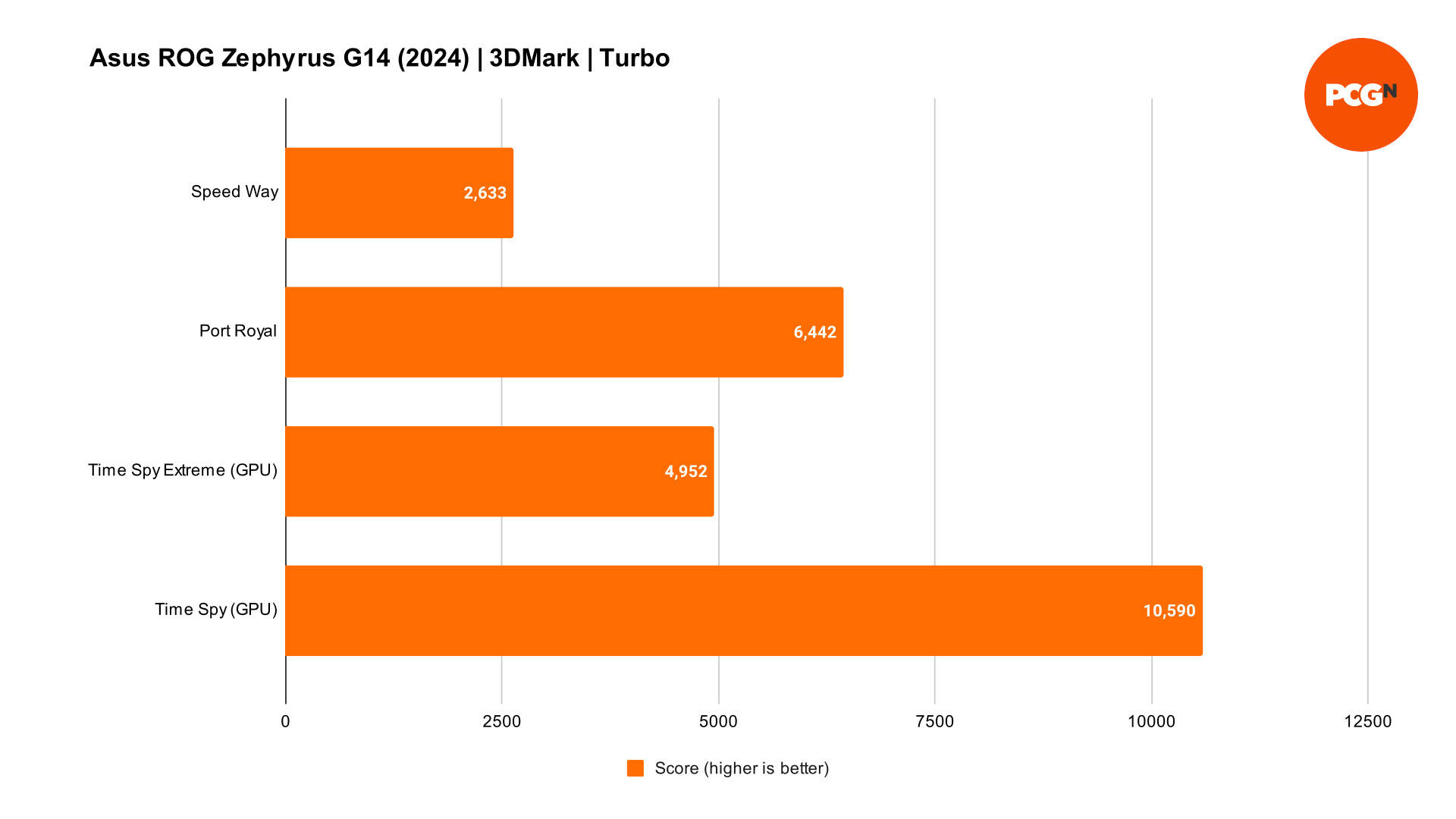
Meanwhile, the 3DMark benchmark suite shows up the clearest parallels between the Zephyrus G14’s RTX 4070 and a desktop RTX 4060. Given the performance we’ve observed thus far, I’d strongly recommend opting for the more expensive configurations of this machine with the RTX 4070 and 32GB of RAM if you can find the additional $400 in your budget, as the longevity of the baseline G14 with a mobile RTX 4060 GPU and 16GB of memory is questionable.
Turning away from worst-case stress tests and benchmarks, though, the Zephyrus G14 is a surprisingly nippy machine that doesn’t need to run its fans at full pelt to get the job done either. Less intense but nonetheless excellent modern games like Baldur’s Gate 3 and Helldivers 2 were a joy to experience on this laptop. Its 14-inch display did mean I couldn’t kick back quite so often, particularly when I needed to read text, but this is true of all laptops of this size.
Motion clarity and responsiveness are excellent on the Zephyrus G14 too, which is no surprise given its 120Hz OLED panel. However, the number of games you’ll be able to run at that refresh rate will prove few and far between without some compromise on your resolution or settings. Still, Nvidia G-Sync does at least allow you to run with an uncapped frame rate without needing to use VSync to avoid screen tearing, which you won’t find on other OLED laptops at the moment.
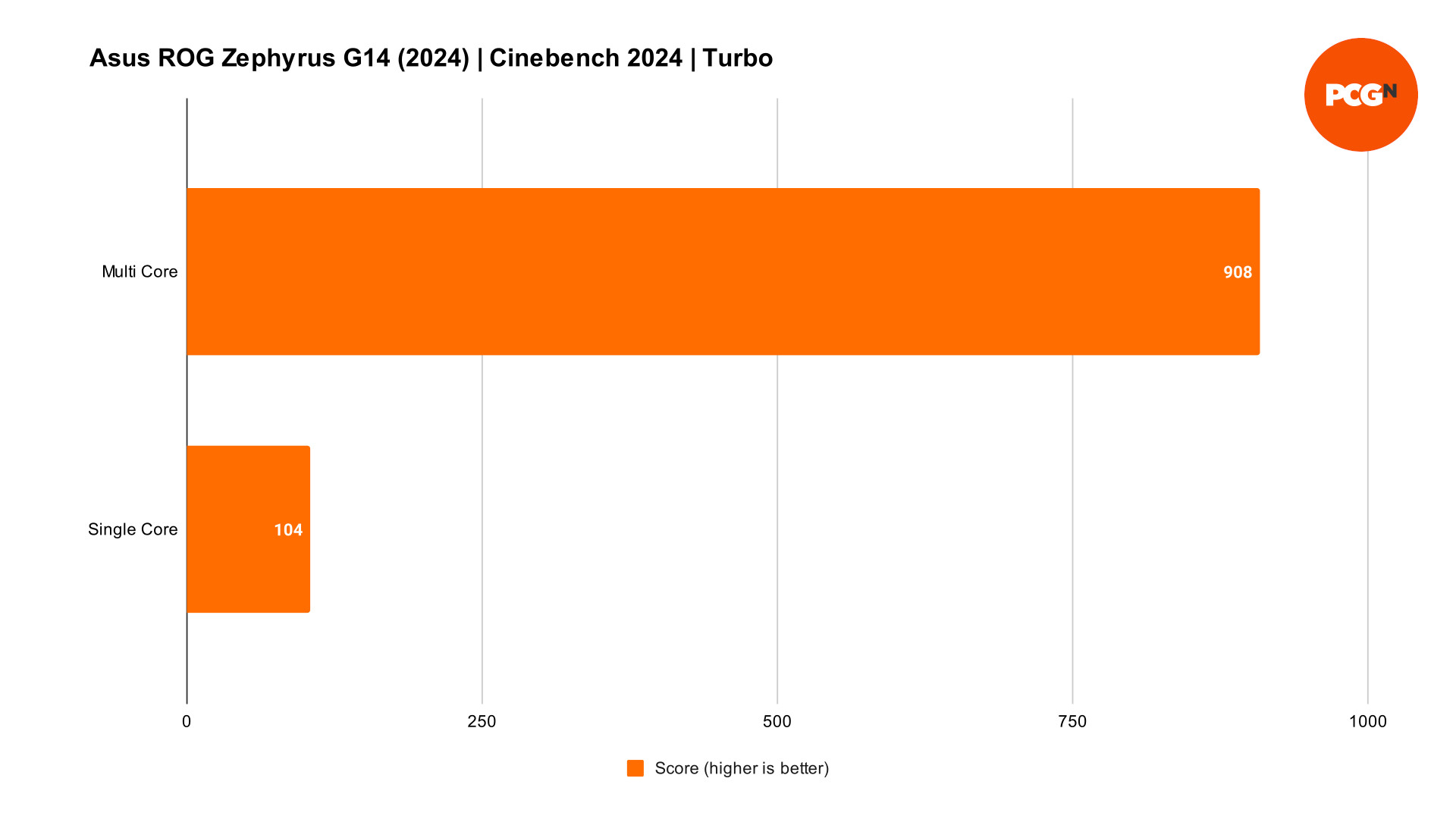
Unsurprisingly, the AMD Ryzen 9 8945HS performs well in both single and multi core Cinebench 2024 benchmarks, just as the Ryzen 9 7940HS did before it. Its eight cores and 16 threads offer plenty of performance for today’s games, and for those to come in the next several years, serving as a suitable pairing for the Zephyrus G14’s RTX 40 series GPUs.
What’s most remarkable about this CPU, though, is its efficiency and thermal performance, keeping a cool head that never rose above 79°C. This is in no doubt partly due to Asus’ well-designed cooling system, and while the Zephyrus G14’s fans will ramp up under load, they’re never as obnoxiously loud as those on larger, spec-heavy laptops, and they’ll more often than not run at an acceptable level. Better still, outside of gaming, they’re practically inaudible.
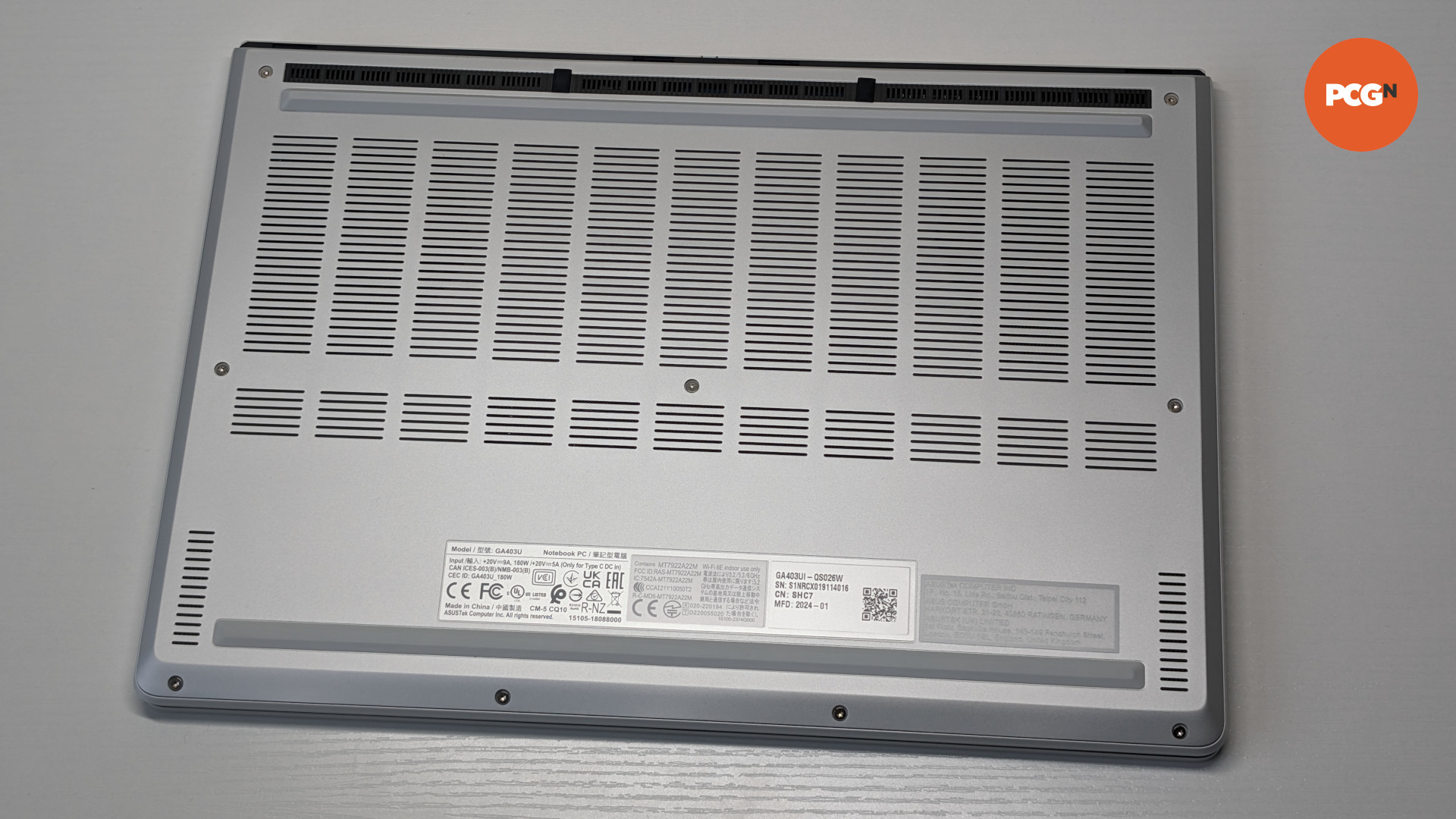
ROG Strix Zephyrus G14 (2024) battery
Reducing the amount of power that its GPU draws naturally offsets the reduction in the size of the ROG Zephyrus G14 (2024)’s battery, with the switch to LPDDR5X memory also assisting. The new rating of 73WHrs, down from 76 WHrs from last year’s laptop, proved to be plenty in our tests.
Using the Zephyrus G14 in a typical workday, I wouldn’t need to reach for the charger until the end of my shift, despite rocking the screen at 80% brightness and using the speakers to listen to some tunes. Even then I’d still have enough juice left for an hour or two of YouTube, impressive stuff.
Battery life is naturally much worse when it comes to gaming, with the Zephyrus G14 lasting just one hour and six minutes in PCMark 10’s ‘Gaming’ benchmark. So, while you can game on this laptop at full pelt for a short stint, you’re still best served with a charger in tow.
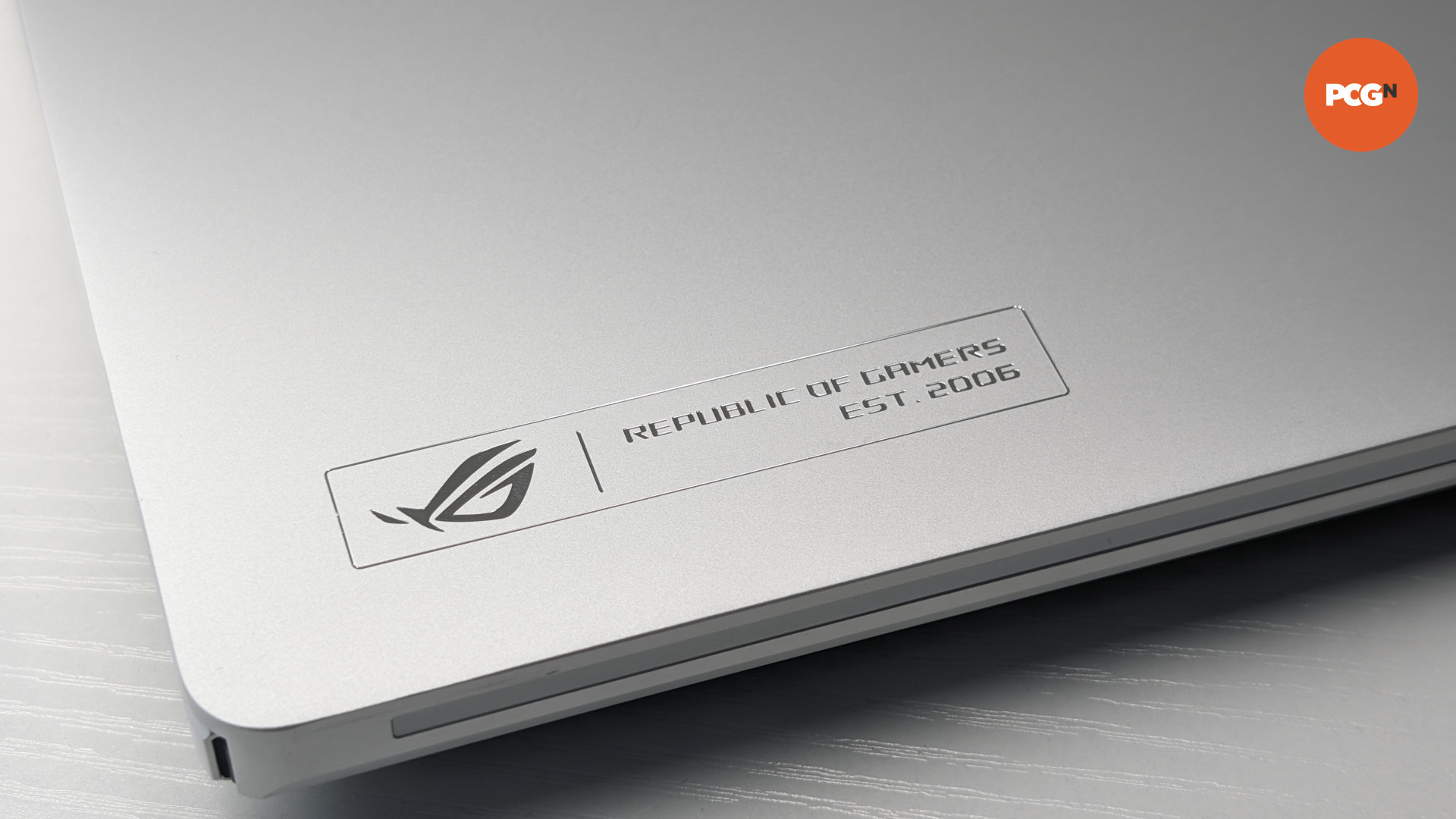
ROG Strix Zephyrus G14 (2024) price
Starting at $1,599.99, the ROG Zephyrus G14 (2024) price is surprisingly affordable for a 14-inch gaming laptop, with competitors like the MSI Stealth 14 commanding the same cost, while others such as the HP Omen Transcend 14 are slightly more expensive.
It isn’t until larger 15.6-inch laptops enter the frame that the Zephyrus G14’s price reveals itself to be firmly on the pricier side. While it’s true that you’ll likely find performance comparable to the G14 in a bigger and cheaper laptop, you certainly won’t find matching build quality or as dazzling a display.
For those looking to save a few bucks, though, last year’s Zephyrus G14 does capture much of what’s on offer with the 2024 model, aside from a few niceties such as the OLED display and improvements to both its keyboard and speakers.
You’ll need to splash out $1,999.99 for our review configuration, but the Zephyrus G14 remains competitive at this price point too. Just remember that you are partly paying for the form factor here, and that there are cheaper options available if you’re comfortable with a larger system.
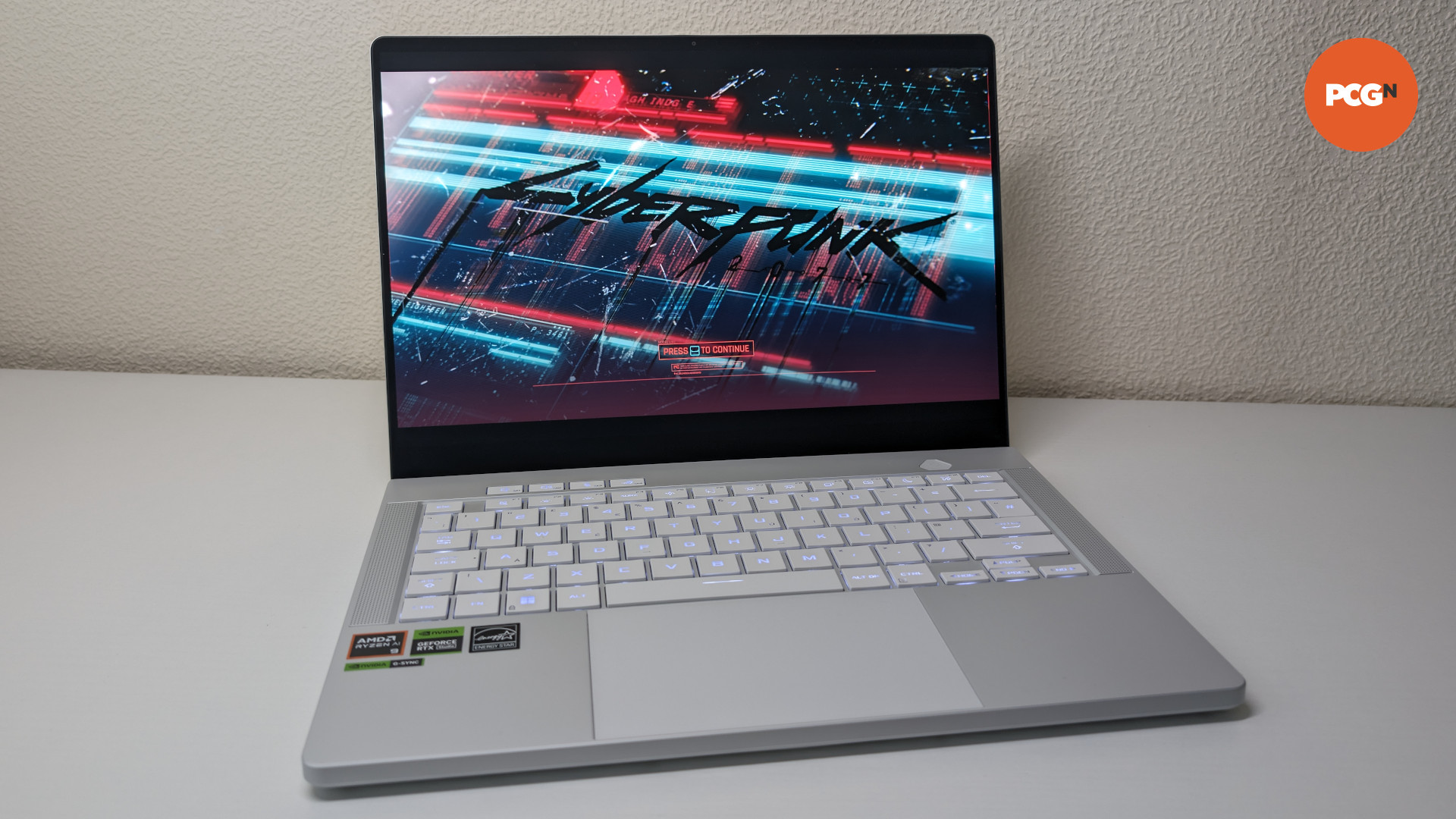
ROG Strix Zephyrus G14 (2024) conclusion
With the new ROG Strix Zephyrus G14 (2024), Asus has crafted the best version of this machine to date, and the finest 14-inch gaming laptop you can buy today. If not for its soldered RAM and the small nuisance of resolution management, I’d describe it as practically perfect.
The Zephyrus G14 just exudes quality, whether you’re typing away, resting your palms on its aluminum alloy chassis, or losing yourself in its vibrant, responsive OLED display. While some may balk at the idea of gaming laptops adopting aesthetics akin to Apple Macbooks, I personally welcome this shift to a more refined and polished look.
The Zephyrus G14 is no slouch when it comes to performance either, despite its size, in some ways reminding me of the Steam Deck OLED (albeit much, much more expensive). While this may be its weakest aspect, relatively speaking, there’s enough power here to last for years to come providing you splash a little extra cash on the top spec, and you’re happy to dial down the resolution.
Simply put, if I had the cash and the need for a small yet powerful laptop, I’d go right ahead and buy the Zephyrus G14, and that recommendation naturally extends to just about everyone in the same spot.
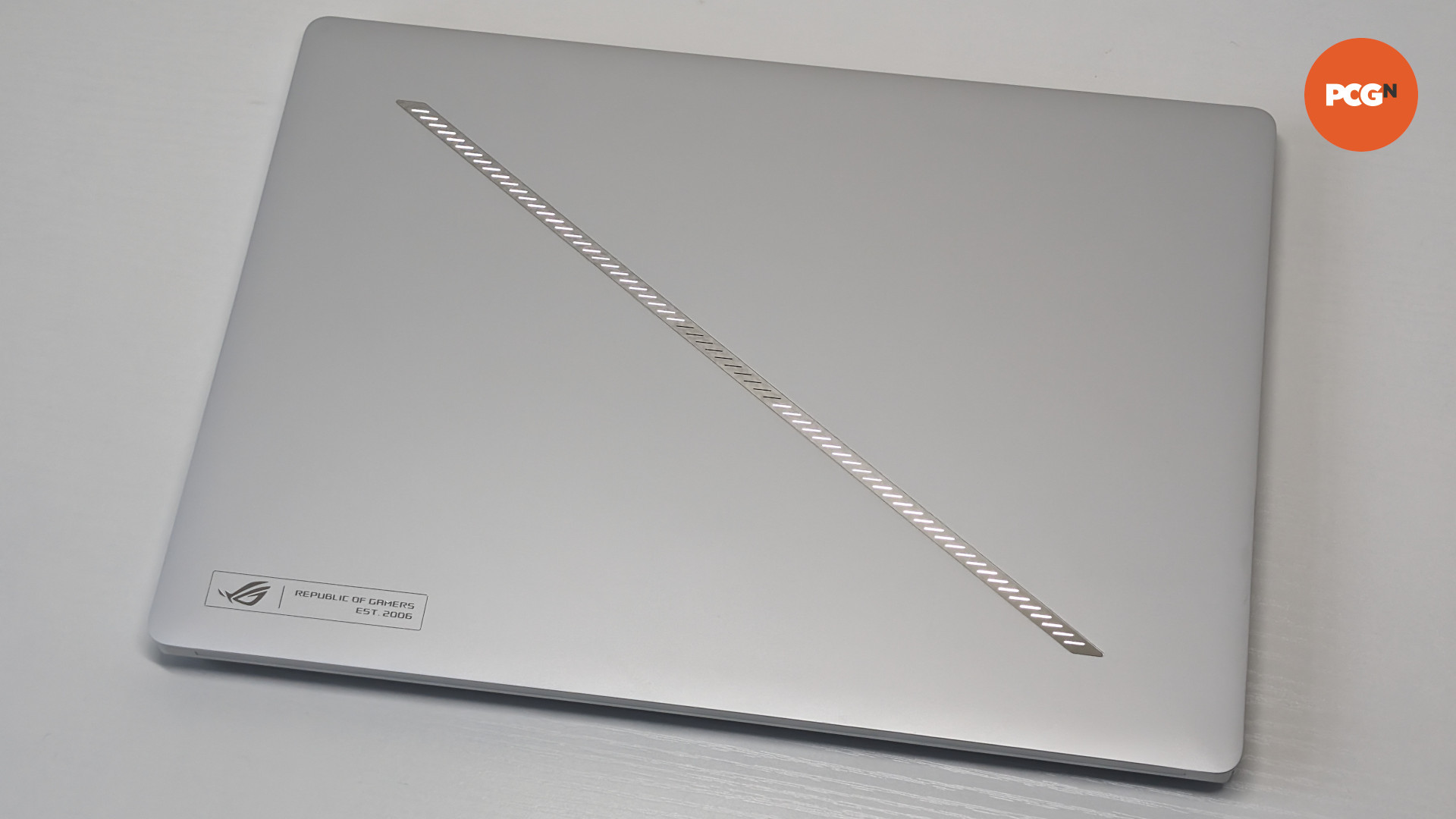
ROG Strix Zephyrus G14 (2024) alternatives
If the ROG Zephyrus G14 (2024) isn’t the right laptop for you, check out these alternatives:
Razer Blade 14 (2024)
While more expensive than the Zephyrus G14 (2024), the Razer Blade 14 (2024) doesn’t skimp on upgradable RAM. However, there are no Mini LED or OLED display options for this laptop, leaving you with a relatively solid but naturally less premium screen.
Asus ROG Zephyrus G16 (2024)
If the appearance and build quality of the Zephyrus G14 (2024) appeal to you, but you wish it had a touch more horsepower, the Zephyrus G16 (2024) has you covered. With a large 16-inch screen, it’s slightly larger than its 14-inch sibling, but its graphics selection tops out at the flagship GeForce RTX 4090.
